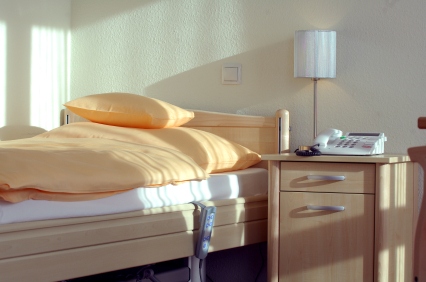Category: Younger residents
Posted by Dr. El - August 27, 2019 - Boomers, Depression/Mental illness/Substance Abuse, McKnight's Long-Term Care News, Resident care, Younger residents

As I discussed in Severely mentally ill residents: A ‘perfect storm’ creates a SNF wave, long-term care has a growing population of severely mentally ill (SMI) residents, with the number of residents diagnosed with schizophrenia or bipolar disorder approaching 20% in some states as of 2017.1
In addition, 46.3% of LTC residents were diagnosed with depression in 2015 and 2016.2 Some were undoubtedly individuals with severe, chronic depression.
People with SMI generally enter nursing facilities for rehabilitation following a fall or some other health crisis. Discharge choices can be limited due to coexisting medical and mental health problems, leading them to become long-term residents despite their relatively young age (an average age of 62 versus 77 in the general nursing home population3).
A review of research on individuals with mental health problems, Physical illness in patients with severe mental disorders, finds that people with SMI have a greater likelihood of physical illness than those without SMI. The authors of the study note that “important individual lifestyle choices, side effects of psychotropic treatment and disparities in health care access, utilization and provision…contribute to these poor physical health outcomes.”
Their research suggests multiple points at which long-term care providers can intervene to assist SMI residents.
Medical assessment
Nurses and physicians can be taught to recognize health problems typical of the SMI population so that they’ll be alert to the increased risk of illnesses such as diabetes, metabolic syndrome, obesity-related cancers, cardiovascular diseases, osteoporosis, hepatitis B/C, tuberculosis, impaired lung function, poor dental status and other concerns.
Staff members who are comfortable physically assessing older residents might need additional training to be at ease evaluating SMI individuals, who may be more physically imposing because of their relative youth, come across as unfamiliar or frightening in their presentation or be themselves uncomfortable with medical tests or interventions.
For the entire article, visit:
Posted by Dr. El - January 15, 2019 - Business Strategies, Depression/Mental illness/Substance Abuse, McKnight's Long-Term Care News, Younger residents

Here’s my latest article on McKnight’s Long-Term Care News:

Long-term care facilities are admitting more residents with longstanding psychiatric illnesses. Such individuals enter the nursing home for physical rehabilitation but are difficult to discharge back to the community due to their mental health needs, weak or nonexistent support networks and unstable prior housing situations.
This column focuses on why the severely mentally ill (SMI) population is increasing, and the impacts of this change and on strategies to manage care.
A mounting possibility
I predict we’ll be seeing greater numbers of SMI residents due to the combination of factors outlined below.
The movement toward deinstitutionalization in the 1970s and 1980s closed many psychiatric facilities without increasing community assistance. Because of the lack of community resources, parents of children with severe mental illness frequently became their lifelong supports.
Many SMI people are now over 50 years old; their caregiver parents are in their seventies and eighties. Older parents are less able to provide financial, practical and emotional aid for their adult children due to their own aging and health problems.
In addition, as adults with SMI get older themselves, they’re increasingly likely to experience medical problems requiring hospitalization and rehab, which brings them to our doors.
To estimate the numbers of older SMI individuals, I looked at statistics on mental illness and aging. According to the National Institute of Mental Health (NIMH), 2.7% of US adults aged 50 and older were diagnosed with SMI in 2016. In 2014, AARPnotes that there were 108.7 million people aged 50 and over in the US. Combining these statistics gives us a rough estimate of almost 3 million SMI adults over age 50 in the US, with the number increasing as the baby boomers age.
I looked at the statistics on LTCfocus.orgto ascertain whether this trend toward increasing numbers of people with SMI in LTC is beginning. The data show the numbers of residents diagnosed with schizophrenia and bipolar disorder between the years of 2000 and 2016. In my state, New York, 6.45% of residents had those diagnoses in 2000; in 2016 it was 11.8%. In Pennsylvania, the numbers increased during that time period from 4.45% to 9.3%. California: 8.87% to 15%. Texas: 4.91% to 13.4%.
The pattern is clear.
As a complicating factor, the US healthcare system has distinguished between treatment for physical health and mental health. There are very few institutional or community resources that are able to care for people with both physical and mental health impairments. There is virtually nowhere to discharge residents without family support who need assistance for comorbid medical disorders and severe mental illness.
Thus we have a perfect storm of treatment failures for our aging severely mental ill population and one that’s likely become more critical as the number of aging SMI individuals increases due to demographic shifts.

Posted by Dr. El - May 1, 2014 - Bullying/Senior bullying, Depression/Mental illness/Substance Abuse, McKnight's Long-Term Care News, Younger residents

Here’s my latest article on McKnight’s Long-Term Care News:

News of the recent double-homicide in a Houston nursing home arrived the morning I was to speak to a group gathered to address the needs of younger residents in long-term care. It didn’t escape anyone in the audience how serious this topic is — the alleged murderer is 56 years old and one of his two victims was 50 years old.
What can organizations do to respond to this terrible news and to reduce the chances that a similar situation could happen in their facilities? Plenty.
Calm fears
· Soothe nerves by pointing out efforts your facility takes to address agitated residents and maintain the safety of the environment (for example, the security guard, video cameras, separating residents in conflict, etc.)
· Minimize the news coverage of the event in common rooms. Residents who want to find out more information can read the newspaper or watch TV privately. It’s not helpful for most residents to listen to an anxiety-provoking rehash of information, especially when they’re unable to get up and leave the room.
Train staff
· Train staff to recognize signs of distress and mental illness in residents and have a system in place that allows the information to be communicated effectively. Aides, for example, don’t have to make a mental health diagnosis; they just need to be able to recognize when a resident is behaving differently and communicate it to the nurse. Train nurses to recognize the importance of the information and to work with the team to assess the resident and intervene appropriately. Mental health issues should be addressed as seriously as physical health concerns and staff should have enough training so that they feel comfortable doing so.
· Train your staff on how to defuse verbally and physically aggressive situations. Staff members without proper training often inadvertently precipitate conflict. (For more on this, download my free report, Stop Agitating the Residents, at MyBetterNursingHome.com.)
For the entire article, visit:

Posted by Dr. El - April 21, 2014 - Business Strategies, Customer service, Depression/Mental illness/Substance Abuse, Resident care, Talks/Radio shows, Younger residents

Join Dr. El this Thursday in Connecticut!
The Connecticut Association of Health Care Facilities
is sponsoring a talk on
Meeting the Needs of Younger Residents
Thursday, April 24th, 2014 at 9am
at the Crowne Plaza Hotel in Cromwell, CT
For more information and to register: CAHCF.org

Posted by Dr. El - July 17, 2013 - Boomers, Business Strategies, Customer service, Talks/Radio shows, Younger residents


I’m honored to be speaking at LeadingAge Florida’s 50th annual convention this year. I’ll be talking tomorrow morning about the anticipated psychosocial needs of baby boomers. If you’re at the convention, please come by to hear me and be sure to say hello afterward. Hope to see you there!
Posted by Dr. El - June 28, 2013 - Books/media of note, Boomers, Business Strategies, McKnight's Long-Term Care News, Resident care, Younger residents

Here’s my latest article at McKnight’s Long-Term Care News:

Young adults in long-term care: a new resource for caregivers
According to a 2010 NPR report, young adults have been one of the fastest growing long-term care populations over the past 10 years, with 14% of nursing home residents under the age of 65. Some live in facilities that have specialized in the care of younger residents and others are in settings where almost all the other residents are seniors.
Both scenarios pose challenges in terms of accommodating the unique physical, emotional, and recreational needs of younger adults — and the reactions of staff members to their young charges.
Having spoken with many young residents and their bewildered staffers over the years, I know firsthand how challenging interactions can be. I wrote about some of the psychological issues and remedies in my 2008 McKnight’s guest column, Young adults in long-term care: the canaries in the coal mine, where I argued that the problems arising with young adults now are precursors to those that will be endemic when the assertive baby boomers arrive at our doors — unless we adapt as providers.
Younger adult toolkit
Recognizing the need for facilities to be better prepared, the American Medical Directors Association has released a toolkit on “The Younger Adult in the Long Term Care Setting” as part of its LTC Information Series. I had the pleasure of working on this project, which covers a wide range of matters affecting young adults and provides recommendations for addressing them.
The guide is one of the few sources of information on this understudied population. If your facility has even one young or boomer resident that staff members consider “demanding” or “a problem,” you’ll find this report invaluable.
For the rest of the article, visit:

Posted by Dr. El - April 30, 2012 - Business Strategies, Customer service, McKnight's Long-Term Care News, Younger residents

Here’s my most recent article in McKnight’s Long-Term Care news online:

The “Single” Boom: Problems and Solutions for Long-Term Care
According to recent reports, one-third of the baby boomers who will be arriving at the doorstep of long-term care are unmarried. Many of them have no children. Just as our healthcare system relies on unpaid family caretakers, LTC relies on close family members who help our residents through their stays.
The demographic trends, however, suggest we need to prepare for increasing numbers of residents without close relatives.
Below are four ways we can expect this shift to impact our residents, and suggestions for how we can adapt to this change:
1. Lack of POAs, healthcare proxies or legal guardians
The Problem: Currently, most residents have someone available in their lives to make medical and legal decisions on their behalf. This trusted helper is able to collect the documents necessary to apply for Medicaid, for example, or to sell a home for the resident.
Typically, family members are informed of the need to sign or gather paperwork, and the nursing home awaits the documents. They generally arrive with or without further prompting, allowing for successful completion of the transactions.
In the absence of an involved family member, these essential activities are virtually impossible for a resident to accomplish independently from inside the nursing home, no matter how robust their condition. Residents, who often make a sudden trip from home to hospital to nursing home, generally don’t have important phone numbers, access to legal papers, Internet connectivity, or the wherewithal to make arrangements on their own, from afar, in the middle of a health crisis.
As we begin to see increasing numbers of elders in this situation, it will become apparent that what we are viewing is not an individual problem, but a systems problem.
The Solution: As a system, we’ll need more court-appointed powers of attorney, proxies and guardians available to our residents, as well as a greater emphasis on obtaining advance directives and community supports. Streamlining the process of obtaining these assistants will make life easier for everyone, and can be accomplished using some of the methods below:
• When assessing social supports upon admission, we can educate residents about the need for assistance in navigating their healthcare. It’s important to plant the seed early in admission because we can expect this idea to meet with resistance as residents struggle to maintain their independence. We can explain that obtaining helpers is not a reflection of a personal failing, but is unavoidable in a complicated healthcare system.
• We can offer increased independence via discussion of advance directives, which allow residents to make their own decisions regarding their healthcare.
• We can discuss with residents who among their family, church, and community members might be willing to assist them with their care and begin outreach toward potential helpers. Offering prepared pamphlets or other educational materials about what is involved in taking on a specific caregiving task will allay the concerns of those considering a helper role and reduce the burden on the social work staff communicating the information.
• Within our facilities, we can increase our connections to the local community. There we might find church volunteers, for example, who would be willing to take an active role in the lives of our residents, such as signing a back-up agreement for home healthcare or becoming a legal guardian.
• We can help residents create a personal caregiving team by connecting more distant relatives or friends who may be able to offer only limited assistance, but together meet the needs of the resident.
• We can increase the number and training of social workers in our centers, so they can take on the additional tasks required to address the above suggestions in a manner that enhances the reputation of the facility.
2. Lack of errand-runners
The Problem: A LTC facility often becomes the resident’s entire world, but not all of their needs can be met within the walls of the facility. A major and important function played by family members is that of procurer of outside items. Currently, residents rely on their family members to bring them home-cooked foods, clothing or items from the community, such as a favorite lotion or shampoo.
Residents without family or friends have come to rely on the kindness of strangers, like their roommate’s daughter, or the friendly aide who makes a grocery store run on her lunch break. This lack of control over formerly simple tasks leads to frustration and depression. Chores such as fixing a watchband become monumental in a nursing home. Using generic toothpaste instead of the brand enjoyed for 70 years can be a twice-daily reminder of lost independence.
Again, what appears to be an individual problem is actually a systems problem within each setting. An increase in the number of single residents will propel us to adjust the way we handle resident needs.
For more, visit McKnight’s Long-Term Care News online: The “Single” Boom: Problems and Solutions for Long-Term Care
Posted by Dr. El - October 5, 2011 - Customer service, Depression/Mental illness/Substance Abuse, Talks/Radio shows, Younger residents

 Will you be in Toronto on October 19th, 2011? Come hear Dr. El speak at the annual convention of the Activity Professionals of Ontario.
Will you be in Toronto on October 19th, 2011? Come hear Dr. El speak at the annual convention of the Activity Professionals of Ontario.
Participants will learn:
- How we react to working with younger residents, and how younger residents react to us as staff members.
- How to use this knowledge to create healthy resident/staff relationships, free of disruptive conflicts.
- What types of activities work best with this population.
- How to create a nursing home environment where younger people thrive.
Want Dr. El to speak at your next event? Call 718-218-DrEl (3537) or Click on the Contact Page
Posted by Dr. El - January 31, 2011 - Anecdotes, Communication, Role of psychologists, Younger residents
“My aide treats me like I’m an idiot,” Katrina typed to me on her talking computer.
“What do you mean?”
“She thinks I don’t know what’s going on!” Her eyes radiated her emotional pain. “She’s a bitch!”
A series of strokes had stolen Katrina’s ability to speak, leaving her a silent observer of her surroundings and interactions. A former schoolteacher, she carefully typed her perspective on the world to me, hunt and peck with one good finger on each hand, then pushed a button that released them in a mechanical female voice. The computer saved her, but it was a slow process and the only way to prepare a sentence in advance was to store it in a memory key. We’d set it up so that Control-H was “Hello.”
“Does she know you can type on the computer?”
“That bitch won’t give me time to type!” Her brows were furrowed and she appeared ready to explode with anger. Her enforced silence was a frequent topic in our sessions.
“Let’s use psychology with her. We’ve got to show her how smart you are. And we need to make a personal connection to shift the dynamics. Is there anything you know about her we can use?”
Katrina thought a moment. “She used to work nights.”
“Perfect! What if we set up a macro that said, ‘How do you like the day shift?’ That way she’d know you knew her well enough to be aware of her schedule, and it would set up a friendly tone.”
Her eyes lit up and she nodded.
“What memory key do you want me to program? Hey, what about B for bitch?”
Katrina laughed.
I set up the macro and she pressed Control-B for practice. “How do you like the day shift,” the mechanical lady said. We discussed her plan: Control-H, Control-B the minute the aide came to her bedside.
———————-
The next week Katrina was beaming when I entered the room.
“Did it work?”
“Everything is different,” she typed. “She talked to me like I knew what was going on!”
“You pressed the key?”
“I didn’t have to! She just knew!” Katrina was smiling from ear to ear.
“Well, isn’t that interesting?” I said. “All we had to do was put it out into the world, and God took care of the rest!”
Posted by Dr. El - December 15, 2010 - Boomers, Depression/Mental illness/Substance Abuse, Resident education/Support groups, Technology, Younger residents
The saying in 12-Step programs such as Alcoholics Anonymous (AA) is that alcoholism is a three-fold disease: physical, mental, and spiritual. The only-half-kidding joke is that alcoholism is a three-fold disease: Thanksgiving, Christmas, and New Year’s. The holidays can be a particularly stressful time for nursing home residents as their celebrations have often changed significantly from those in the past. The loss of family members, the inability to get around independently, and the lack of opportunity and funds to shop for gifts can take their toll on residents who may have had trouble with the holidays even before they entered the nursing home.
In case you haven’t been persuaded by my previous arguments for holding AA meetings in nursing homes (or in case you’ve been persuaded but your administration hasn’t) there are also telephone meetings available to residents for the cost of a phone call. Callers can listen in, or share their story if they wish, in an anonymous environment. Below are links to the telephone meeting lists of several 12-Step programs.
Alcoholics Anonymous
Al-Anon (for family and friends of alcoholics)
Overeaters Anonymous
Nicotine Anonymous












 Will you be in Toronto on October 19th, 2011? Come hear Dr. El speak at the annual convention of the
Will you be in Toronto on October 19th, 2011? Come hear Dr. El speak at the annual convention of the 